Insert bullet points in Excel to transform your lists and text entries into clear, concise, and visually appealing content. This simple yet impactful formatting technique is essential for anyone aiming to present information in an organized manner, whether it’s in project plans, inventory lists, or summary reports. By incorporating bullet points, you can enhance the readability of your data, making it easier for viewers to process and understand key points at a glance. This guide will provide you with straightforward instructions on how to effectively insert bullet points in Excel, ensuring your spreadsheets are not only functional but also aesthetically pleasing and user-friendly.
This Tutorial Covers:
- Using a Keyboard Shortcut
- Using the Dialog Box with Insert Symbol
- CHAR Function usage
- Formatting Custom Numbers
- Taking a list from MS Word or PowerPoint and pasting it
- Duplicate the bullet points in a single cell
- Duplicate the bullets in several cells
- How to use SmartArt to create bullet points in Excel
1. Using a Keyboard Shortcut to insert bullet points
If your keyboard has a numeric keypad:
Step 1: Decide the cell you wish to place the bullet in. To enter edit mode, either double-click the cell or press F2 -.
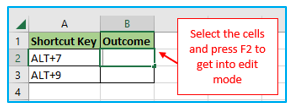
Step 2: Press 7 or 9 while holding down the ALT key, then release it. A bullet would appear as soon as you let off of the ALT key. A different type of bullet is inserted by pressing ALT + 7 and ALT + 9 (see below):
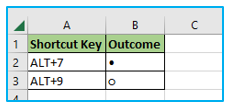
Repeat the following instructions if you don’t have a numeric keyboard (like my laptop), or try ALT + FUNCTION + 7 instead.
If you have a list in a single cell and wish to add extra bullets in excel, simply follow the same instructions.
To create a list in a cell, for instance, type the bullet, the item name, Alt + Enter to add a line break, and then insert the bullet once again (as illustrated below):
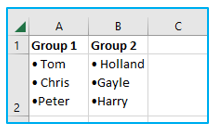
Note: You can replicate the bullet point in excel just like any other character once it is in a cell.
2. Using the Dialog Box with Insert Symbol
Excel’s Insert Symbol function can be used to add bullet points.
The following steps:
Step 1: Select “Insert” and then “Symbols.”

Step 2: Choose the “Font” by using the drop-down menu under the “Symbols” tab of the “Symbol” dialogue box. Choose the bullet you want to place by advancing the symbol list. You can also choose the bullet point by entering “2022” in the “Character code” box. On the Insert button, click.
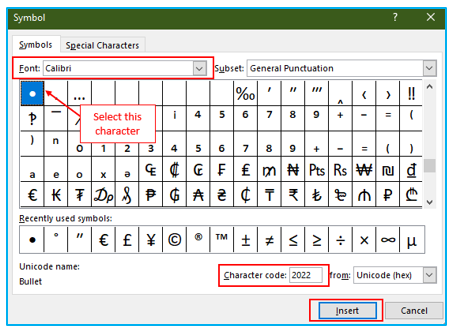
This will place the bullet in the cell you’ve chosen. You can copy-paste the bullet anywhere you need it after it is in a cell.
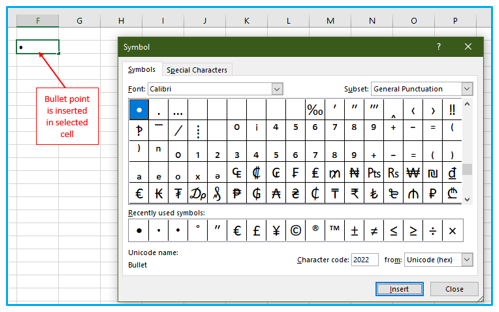
3. CHAR Function usage
Additionally, Excel’s CHAR function allows you to add bullet points.
In Excel, if you type =CHAR(149), it instantly turns into a bullet.

When you have a list of items and want to add a bullet to each item at once, this could be beneficial. As demonstrated below:
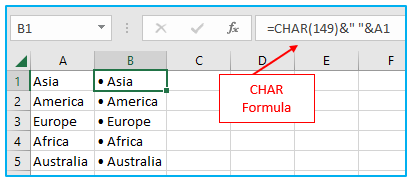
In the example above, the list of continents in A1:A5 was expanded with bullet points. The formula used in cell B1 is as follows:
=CHAR(149)&” “&A1
A space character ensures that there is space after the bullet and before the item name, and CHAR(149) inserts the bullet.
4. Formatting Custom Numbers
Create a custom number format that will automatically insert bullet points in Excel if you want to avoid the hassle of repeatedly entering bullet symbols into each cell.
Here is the information you need to know about custom number formatting in Excel before I explain the trick. You can choose the format for four different types of data with this feature:
<Positive numbers> ; <Negative Numbers> ; <Zeroes> ; <Text>
You can determine how each of these data types is displayed in the cell using custom number formatting.
By doing this, I can modify the cells so that as you add data into them, a bullet is automatically displayed.
The steps to insert excel bullet points are as follows:
Step 1: Put a bullet in any cell (use the shortcut or insert symbol technique shown above). To duplicate a bullet, simply double-click on the cell where it appears (or use F2 to enter edit mode first).
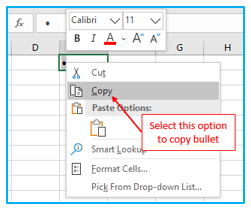
Step 2: Decide which cells you wish to apply the customized number format to (so that the bullet points are automatically inserted).
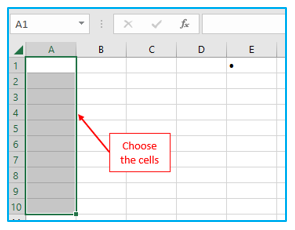
Step 3: Toggle Control + 1. It will display the “Format Cells” Dialogue box.
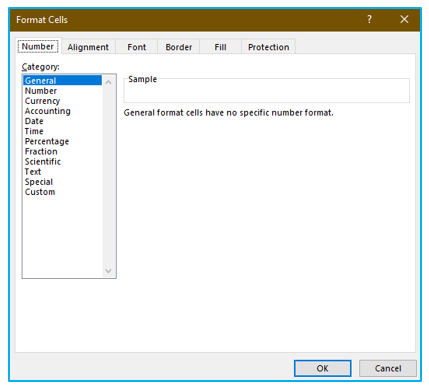
Step 4: Go to the Number Tab and choose Custom. Enter “• General;• General;• General;• General” in the type field. Select OK.
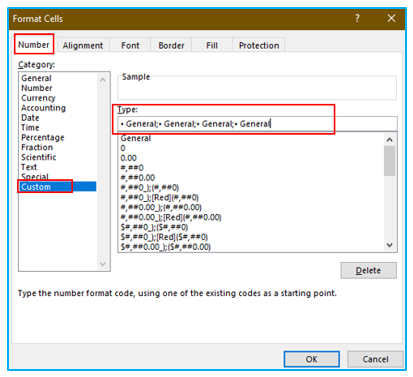
That’s all there is to it. Try entering anything in the cells. It will automatically display the first bullet.
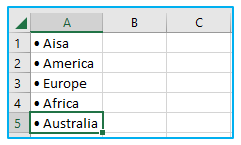
5. Taking a list from MS Word or PowerPoint and pasting it
A list with bullet points from Microsoft Word can be readily copied and pasted into Excel.
If you have a Word list of bullet points, you can paste it into Excel and either have each bullet point appear in a separate cell or in a single cell.
Note: When put into Excel, copied lists from Word and PowerPoint behave somewhat differently.
- Duplicate the bullet points in a single cell:
Step 1: Copy the Word bullet points.
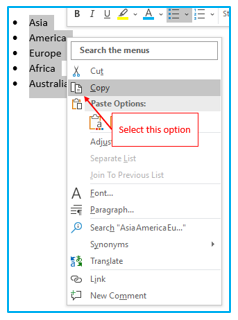
Step 2: To copy the list, double-click the cell you want it in. (Or use F2 to switch into edit mode first.) To paste it, press Control + V. With this, the bullet list will be pasted into the same cell.
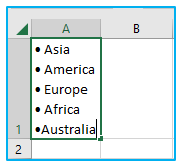
Note: PowerPoint and Microsoft Word act differently in this situation. The PowerPoint bullet list is pasted without the bullet points, whereas the one from Word is pasted exactly as is (as shown above).
- Duplicate the bullets in several cells:
Step 1: Copy the bullets from PowerPoint or Word.
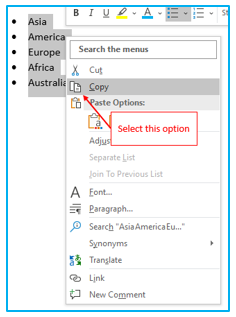
Step 2: Decide which cell you wish to copy the list to. To paste it, press Control + V.
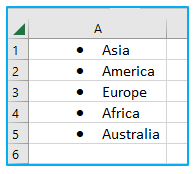
6. How to use SmartArt to create bullet points in Excel?
The most enjoyable portion is reserved for last:) Use the SmartArt tool in Excel 2007, 2010, 2013, 2016, 2019 and 2021 if you’re searching for something more ornate and artistic.
The steps to create bullet points using SmartArt in Excel are described below:
Step 1: Click on SmartArt under the Illustrations group in the Insert tab.

Step 2: Select “List” from the “Categories” menu, then click the graphic you want to add and then “OK.” We’re going to use a “Vertical Bullet List” for this example.
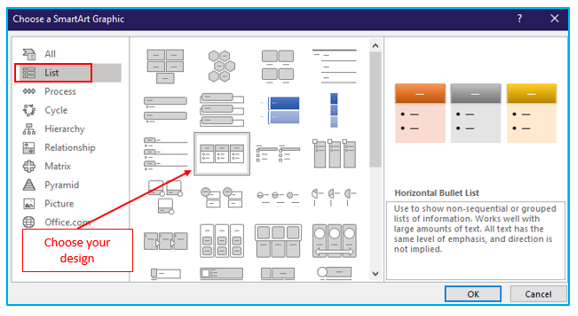
Step 3: As you type your list items on the text pane with the “SmartArt” visual chosen, Excel will automatically add bullets as you type:
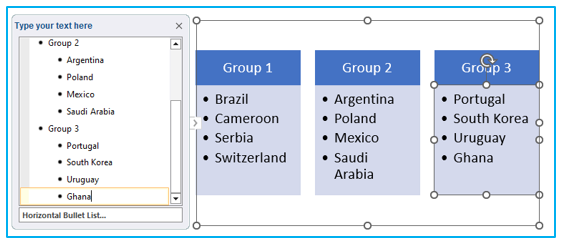
Step 4: When finished, switch to the “SmartArt Tools” tabs and experiment with different colors, layouts, shape and text effects, etc. to create your bullet list.
Here are the alternatives I used to further adorn my Excel bulleted list to offer you some inspiration:
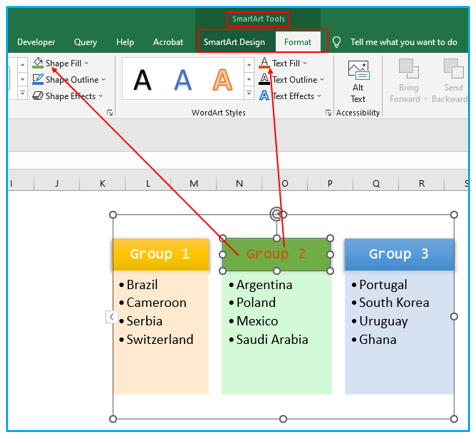
You may be interested:
